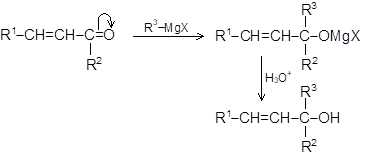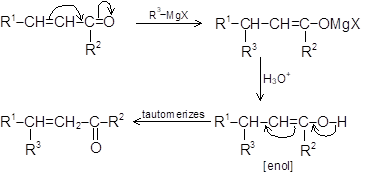Grignard reagent and its application in organic reactions
Grignard reagent and its application
When a solution of an alkyl halide in dry ethyl ether, (C2H5)2O, is allowed to stand over turnings of metallic magnesium, a vigorous reaction takes place. The solution turns cloudy, begins to boil and the magnesium metal gradually disappears. The resulting solution is known as Grignard reagent. It is one of the most useful and versatile reagents known to the organic chemists. Check out Chemistry Formulas and NCERT Solutions for class 11 Chemistry prepared by Physics Wallah.
RX + Mg  RMgX
RMgX
Alkyl halide Alkyl magnesium halide
The Grignard reagent has the general formula RMgX, and the general name alkyl magnesium halide. The carbon−magnesium bond is covalent but highly polar, with carbon pulling away electrons from electropositive magnesium but the magnesium−halogen bond is essentially ionic,
Since magnesium becomes bonded to the same carbon that previously held halogen, the alkyl group remains intact during the preparation of the reagent. Thus, n−propyl chloride yields n−propyl magnesium chloride and isopropyl chloride yields isopropyl magnesium chloride.
CH3CH2CH2Cl + Mg  CH3CH2CH2MgCl
CH3CH2CH2MgCl
n−Propyl chloride n−Propyl magnesium chloride
(CH3)2CHCl + Mg  (CH3)2CHMgCl
(CH3)2CHMgCl
Isopropyl chloride Isopropyl magnesium chloride
Mechanism of Grignard Reagents
The Grignard reagent belongs to a class of compounds called organometallic compounds, in which carbon is bonded to a metal like lithium, potassium, sodium, zinc, mercury, lead, thallium or to almost any metal known. Each kind of organometallic compound has its own set of properties and its particular uses depend on these. But whatever the metal, it is less electronegative than carbon and the carbon−metal bond is always highly polar. Although the organic group is not a full-fledged carbanion but has considerable carbanionic characters. Thus, organometallic compounds can serve as a source of carbon bearing negative charge.
The Grignard reagent has the formula RMgX and is prepared by the reaction of metallic magnesium with the appropriate organic halide. This halide can be alkyl (1°, 2°, 3°), allylic, aryl alkyl (e.g. benzyl), or aryl (phenyl) or substituted phenyl. The halogen may be −Cl, −Br or −I, (Aryl magnesium chlorides must be made in the cyclic ether tetrahydrofuran instead of ethyl ether). Aldehydes and ketones resemble each other closely in most of their reactions. The carbonyl group is also unsaturated and like the carbon−carbon bond, it also undergoes addition. One of the typical reaction is cis addition of the Grignard reagent.
The electrons of the carbonyl double bond hold together atoms of different electronegativity, thus, the electrons are not equally shared, the mobile π−cloud is pulled strongly towards the more electronegative atom, oxygen. The addition of an unsymmetrical reagent happens such that the nucleophilic (basic) portion attaches itself to carbon and the electrophilic (acidic) portion attaches itself to oxygen.
The carbon−magnesium bond of the Grignard reagent is a highly polar bond, carbon being negative relative to electropositive magnesium. When Grignard reagent is added to carbonyl compounds, the organic group attaches to carbon and magnesium to oxygen.

The product is a magnesium salt of the weakly acidic alcohol and is easily converted into the alcohol by the addition of the stronger acid, water. The Mg(OH)X thus formed is a gelatinous material, which forms coating over carbonyl compound, thus dilute mineral acid (HCl, H2SO4) is commonly used instead of water, so that water−soluble magnesium salts are formed.
PRODUCTS OF THE GRIGNARD SYNTHESIS:
The type of alcohol that is obtained from a Grignard synthesis depends upon the type of carbonyl compound used. Formaldehyde (HCHO) yields primary alcohols, other aldehydes (RCHO) yield secondary alcohols and ketones (R2CO) yield tertiary alcohols. The number of hydrogens attached to the carbonyl carbon defines the carbonyl compound as formaldehyde, higher aldehydes or ketone. The carbonyl carbon is the one that finally bears the −OH group in the product and the number of hydrogen defines the alcohol as primary, secondary, or tertiary.







Reactivity order of the substrates with a Grignard reagent is
Active −H compounds > –CHO >  > –COCl > –CO2R > –CH2X.
> –COCl > –CO2R > –CH2X.
Higher the steric hindrance lower will be rate of Grignard Reagents
EXCEPTIONAL BEHAVIOUR OF GRIGNARD REAGENT:
Sometimes, Grignard reagent does not react with compounds containing functional group normally capable of undergoing reaction. Generally, branching of the carbon chain near the functional group prevents the reaction. For example, methyl magnesium bromide or iodide does not react with hexamethyl acetone (CH3)3CCOC(CH3)3. It has also been found that if Grignard reagent contains large alkyl groups, reaction may be prevented. For example, isopropyl methyl acetone reacts with methyl magnesium iodide but not with t−butyl magnesium iodide. In other cases, abnormal reaction may take place. For example, when isopropyl magnesium bromide is added to diisopropyl ketone, the expected tertiary alcohol is not formed, instead the secondary alcohol, di−isopropyl carbinol is obtained resulting from the reduction of the ketone.
(CH3)2CHCOCH(CH3)2  (CH3)2 CHCH (OH) CH (CH3)2 + CH3CH=CH2
(CH3)2 CHCH (OH) CH (CH3)2 + CH3CH=CH2
α, β−unsaturated carbonyl compounds adds on Grignard reagents at the 1, 2 or 1, 4−positions.
1, 2−addition:

1, 4−addition:

The reaction of dihalides of the type Br(CH2)nBr with magnesium depends on the value of n. For n = 1, no Grignard reagent is formed. For example,

When n ≥ 4, the Grignard reagent can be possibly made with dibromo compound i.e, Br(CH2)nBr.
Recent Concepts
- How to calculate equivalent weight ?
- What is equivalent weight of oxalic acid
- Atomic weight of elements
- What is Limiting Reagents ?
- Molarity
- Define back bonding in BF3
- Heisenberg's Uncertainty Principle
- What are Inert pair effects
- Quantum Numbers
- What is the boron trifluoride formula?
- What is the Structure of orthoboric acid ?
- What is the Structure of Borax ?
- What is the structure of diboranes ?
- LiAlH4 Reaction and Mechanism
- Grignard reagent and its application in organic reactions
- How Haloform reaction proceed ?
- What is Oxirane ?
- Acidity of Phenols
- Explain the mechanism of Bromination of Phenol
- what is a chemical reaction?










